The Cast and Characters They Played
If we wanted to keep a record of actors and the roles they played like this:
| Actor/Actress | Character |
|---|---|
| Keanu Reeves | Neo |
| Laurence Fishburne | Morpheus |
| Carrie-Anne Moss | Trinity |
We need a table MovieCast with columns like:
| MovieCastId | MovieId | PersonId | Character |
|---|---|---|---|
| ... | ... | ... | ... |
| 11 | 2 (Matrix) | 77 (Keanu Reeves) | Neo |
| 12 | 2 (Matrix) | 99 (Laurence Fisburne) | Morpheus |
| 13 | 2 (Matrix) | 30 (Carrie-Anne Moss) | Trinitity |
| ... | ... | ... | ... |
It's clear that we also need a Person table as we'll keep actors/actresses by their ID.
It's better to call it Person as actors/actresses might become directors, scenario writers and such later.
Creating Person and MovieCast Tables
Now its time to create a migration with two tables:
MovieTutorial.Web/Modules/Common/Migrations/DefaultDB/DefaultDB_20151025_170200_PersonAndMovieCast.cs:
using FluentMigrator;
using System;
namespace MovieTutorial.Migrations.DefaultDB
{
[Migration(20151025170200)]
public class DefaultDB_20151025_170200_PersonAndMovieCast : Migration
{
public override void Up()
{
Create.Table("Person").InSchema("mov")
.WithColumn("PersonId").AsInt32().Identity()
.PrimaryKey().NotNullable()
.WithColumn("Firstname").AsString(50).NotNullable()
.WithColumn("Lastname").AsString(50).NotNullable()
.WithColumn("BirthDate").AsDateTime().Nullable()
.WithColumn("BirthPlace").AsString(100).Nullable()
.WithColumn("Gender").AsInt32().Nullable()
.WithColumn("Height").AsInt32().Nullable();
Create.Table("MovieCast").InSchema("mov")
.WithColumn("MovieCastId").AsInt32().Identity()
.PrimaryKey().NotNullable()
.WithColumn("MovieId").AsInt32().NotNullable()
.ForeignKey("FK_MovieCast_MovieId", "mov", "Movie", "MovieId")
.WithColumn("PersonId").AsInt32().NotNullable()
.ForeignKey("FK_MovieCast_PersonId", "mov", "Person", "PersonId")
.WithColumn("Character").AsString(50).Nullable();
}
public override void Down()
{
}
}
}
Generating Code For Person Table
First generate code for Person table:
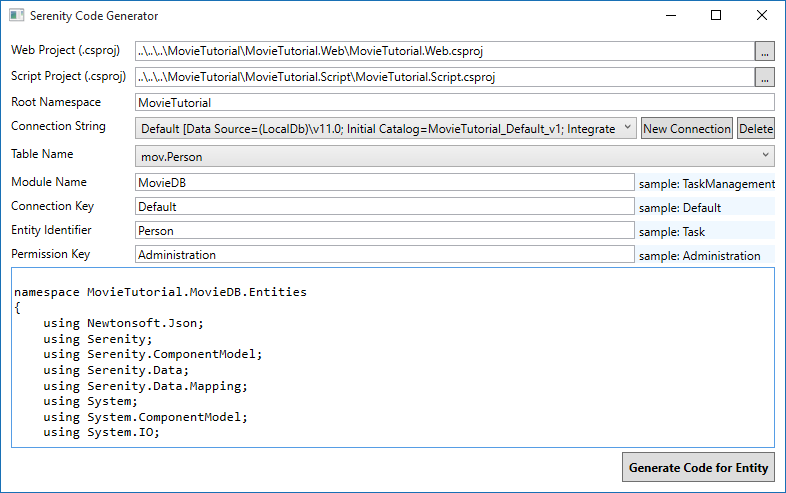
Changing Gender To Enumeration
Gender column in Person table should be an enumeration. Declare a Gender enumeration in Gender.cs next to PersonRow.cs:
using Serenity.ComponentModel;
using System.ComponentModel;
namespace MovieTutorial.MovieDB
{
[EnumKey("MovieDB.Gender")]
public enum Gender
{
[Description("Male")]
Male = 1,
[Description("Female")]
Female = 2
}
}
Change Gender property declaration in PersonRow.cs as below:
//...
[DisplayName("Gender")]
public Gender? Gender
{
get { return (Gender?)Fields.Gender[this]; }
set { Fields.Gender[this] = (Int32?)value; }
}
//...
For consistency, change type of Gender property in PersonForm.cs and PersonColumns.cs from Int32 to Gender.
Rebuilding T4 Templates
As we declared a new enumeration and used it, we should rebuild solution, convert T4 templates
If you are using a Serene version before 1.6.0, delete partial MovieRow declaration from MovieGrid.cs.
Now after launching your project, you should be able to enter actors:
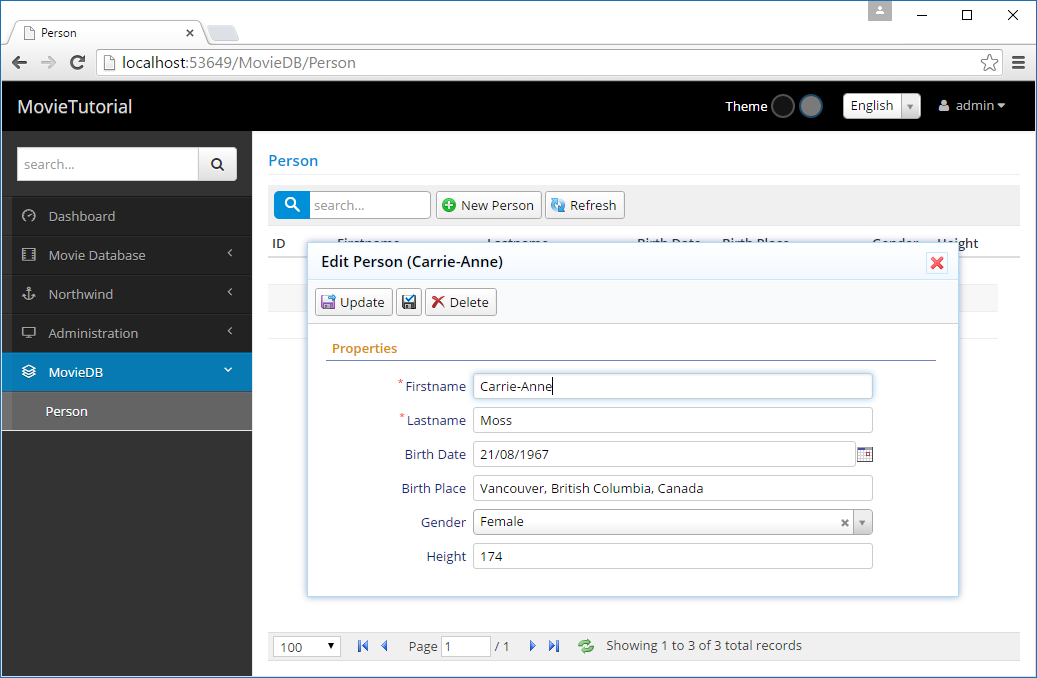
Declaring FullName Field
On the title of edit dialog, first name of the person is shown (Carrie-Anne). It would be nice to show full name. And also search with full name in grid.
So let's edit our PersonRow.cs:
namespace MovieTutorial.MovieDB.Entities
{
//...
public sealed class PersonRow : Row, IIdRow, INameRow
{
//... remove QuickSearch from FirstName
[DisplayName("First Name"), Size(50), NotNull]
public String Firstname
{
get { return Fields.Firstname[this]; }
set { Fields.Firstname[this] = value; }
}
[DisplayName("Last Name"), Size(50), NotNull]
public String Lastname
{
get { return Fields.Lastname[this]; }
set { Fields.Lastname[this] = value; }
}
[DisplayName("Full Name"),
Expression("(t0.Firstname + ' ' + t0.Lastname)"), QuickSearch]
public String Fullname
{
get { return Fields.Fullname[this]; }
set { Fields.Fullname[this] = value; }
}
//... change NameField to Fullname
StringField INameRow.NameField
{
get { return Fields.Fullname; }
}
//...
public class RowFields : RowFieldsBase
{
public readonly Int32Field PersonId;
public readonly StringField Firstname;
public readonly StringField Lastname;
public readonly StringField Fullname;
//...
}
}
}
We specified SQL expression Expression("(t0.Firstname + ' ' + t0.Lastname)") on top of Fullname property. Thus, it is a server side calculated field.
By adding QuickSearch attribute to FullName, instead of Firstname, grid will now search by default on Fullname field.
But still dialog will show Firstname. For this, we need to make a change
First transform templates, and then make change below in PersonDialog.cs:
namespace MovieTutorial.MovieDB
{
using jQueryApi;
using Serenity;
using System.Collections.Generic;
[IdProperty("PersonId"), NameProperty(PersonRow.Fields.Fullname)]
[FormKey("MovieDB.Person"), LocalTextPrefix("MovieDB.Person"),
Service("MovieDB/Person")]
public class PersonDialog : EntityDialog<PersonRow>
{
}
}
For compile time checking, instead of writing *NameProperty("Fullname"), i used the field name generated by T4 templates.
We can also use similar information for other attributes:
namespace MovieTutorial.MovieDB
{
using jQueryApi;
using Serenity;
using System.Collections.Generic;
[IdProperty(PersonRow.IdProperty), NameProperty(PersonRow.NameProperty)]
[FormKey(PersonForm.FormKey), LocalTextPrefix(PersonRow.LocalTextPrefix),
Service(PersonService.BaseUrl)]
public class PersonDialog : EntityDialog<PersonRow>
{
}
}
PersonRow.NameProperty corresponds to NameField set at server side.
Now we have full name at the title of PersonDialog.
While we are still here, let's declare a LookupScript for Person table:
namespace MovieTutorial.MovieDB.Entities
{
//...
[LookupScript("MovieDB.Person")]
public sealed class PersonRow : Row, IIdRow, INameRow
//...
We'll use it for editing Movie cast later.
Generating Code For MovieCast Table
Generate code for MovieCast table using sergen:
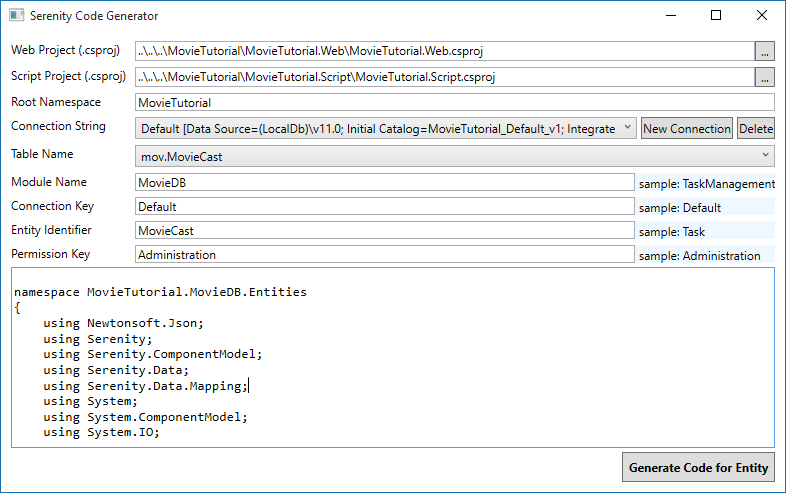
Master/Detail Editing Logic For MovieCast Table
Up until now, we created a page for each table, and list and edit its records in that page. This time we are going to use a different strategy.
We'll list the cast for a movie in the Movie dialog and allow them to be edited along with the movie. Also, cast will be saved together with movie entity in one transaction.
Thus, cast editing will be in memory, and when user presses save button in Movie dialog, the movie and its cast will be saved to database in one shot (one transaction).
It would be possible to edit the cast independently, here we just want to show how it can be done.
For some types of master/detail records like order/detail, details shouldn't be allowed to be edited independently for consistency reasons. Serene already has a sample for this kind of editing in Northwind/Order dialog.
Getting Required Base Classes From Serene Template 1.5.9+
You will probably won't need this step, but as i started this tutorial before Order/Detail editing sample was in Serene, i have to take three classes from a recent template.
This is just a sample on how to get new features from a more recent Serene template.
So i will create a new Serene application (NewApp), take these three files below from it:
NewApp.Script/Common/Helper/GridEditorBase.cs
NewApp.Script/Common/Helper/GridEditorDialog.cs
NewApp.Web/Modules/Common/Helpers/DetailListSaveHandler.cs
Copy them under
MovieTutorial.Script/Common/Helper/GridEditorBase.cs
MovieTutorial.Script/Common/Helper/GridEditorDialog.cs
MovieTutorial.Web/Modules/Common/Helpers/DetailListSaveHandler.cs
Include them in project and replace NewApp text with MovieTutorial.
Once these base classes are stable and flexible enough, they will be integrated to Serenity itself.
Creating an Editor For Movie Cast List
Next to MovieCastGrid.cs (at MovieTutorial.Script/MovieDB/MovieCast/), create a file named MovieCastEditor.cs with contents below:
namespace MovieTutorial.MovieDB
{
using Common;
using jQueryApi;
using Serenity;
using System.Linq;
[ColumnsKey("MovieDB.MovieCast"), LocalTextPrefix("MovieDB.MovieCast")]
public class MovieCastEditor : GridEditorBase<MovieCastRow>
{
public MovieCastEditor(jQueryObject container)
: base(container)
{
}
}
}
Please DON'T use Visual Studio add item menus to create a .cs file in script project. Use copy paste to create a new file and modify it. Otherwise, Visual Studio adds a System reference to Script project, which is not compatible with Saltarelle. You need to remove System reference if you did that mistake.
To reference this new editor type from server side, rebuild solution, transform all templates (if using an old version, remove that useless MovieCastRow partial from MovieGrid.cs, and build again (i had to re-run templates)
Using MovieCastEditor in Movie Form
Open MovieForm.cs, between Description and Storyline fields, add a CastList property like:
namespace MovieTutorial.MovieDB.Forms
{
//...
public class MovieForm
{
public String Title { get; set; }
[TextAreaEditor(Rows = 3)]
public String Description { get; set; }
[MovieCastEditor]
public List<Entities.MovieCastRow> CastList { get; set; }
[TextAreaEditor(Rows = 8)]
public String Storyline { get; set; }
//...
}
}
By putting [MovieCastEditor] attribute on top of CastList property, we specified that this property will be edited by our new MovieCastEditor type which is defined in script code.
We could also write [EditorType("MovieDB.MovieCast")] but who really likes hard-coded strings? Not me...
Now build and launch your application. Open a movie dialog and you'll be greeted by our new editor:
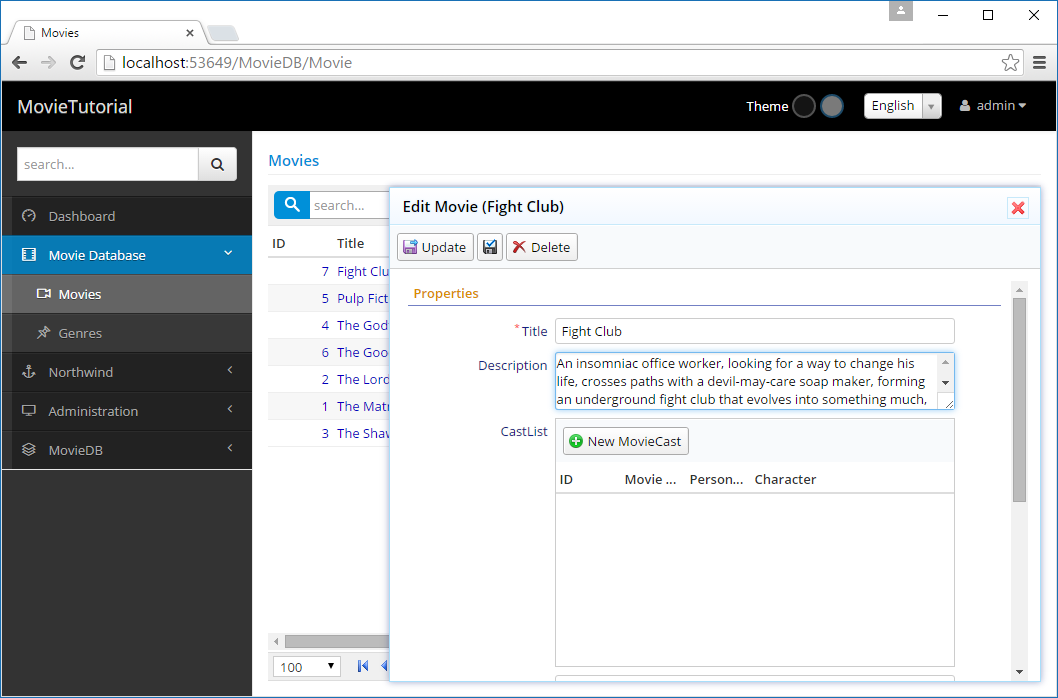
OK, it looked easy, but i'll be honest, we are not even half the way.
That New MovieCast button doesn't work, need to define a dialog for it, the grid columns are not what i'd like them to be and the field and button titles are not so user friendly...
Also as this is not an integrated feature (yet), i have to handle a bit more plumbing like loading and saving cast list on server side.
Configuring MovieCastEditor to Use MovieCastEditDialog
Get a copy of MovieCastDialog.cs as MovieCastEditDialog.cs and modify it like below:
namespace MovieTutorial.MovieDB
{
using jQueryApi;
using Common;
using Serenity;
using System.Collections.Generic;
[NameProperty("Character"), FormKey("MovieDB.MovieCast"),
LocalTextPrefix("MovieDB.MovieCast")]
public class MovieCastEditDialog : GridEditorDialog<MovieCastRow>
{
}
}
Open MovieCastEditor.cs again and add a DialogType attribute and override GetAddButtonCaption:
namespace MovieTutorial.MovieDB
{
//..
[DialogType(typeof(MovieCastEditDialog))]
public class MovieCastEditor : GridEditorBase<MovieCastRow>
{
public MovieCastEditor(jQueryObject container)
: base(container)
{
}
protected override string GetAddButtonCaption()
{
return "Add";
}
}
}
We specified that MovieCastEditor uses a MovieCastEditDialog by default which is also used by Add button.
Now, instead of doing nothing, Add button shows a dialog.
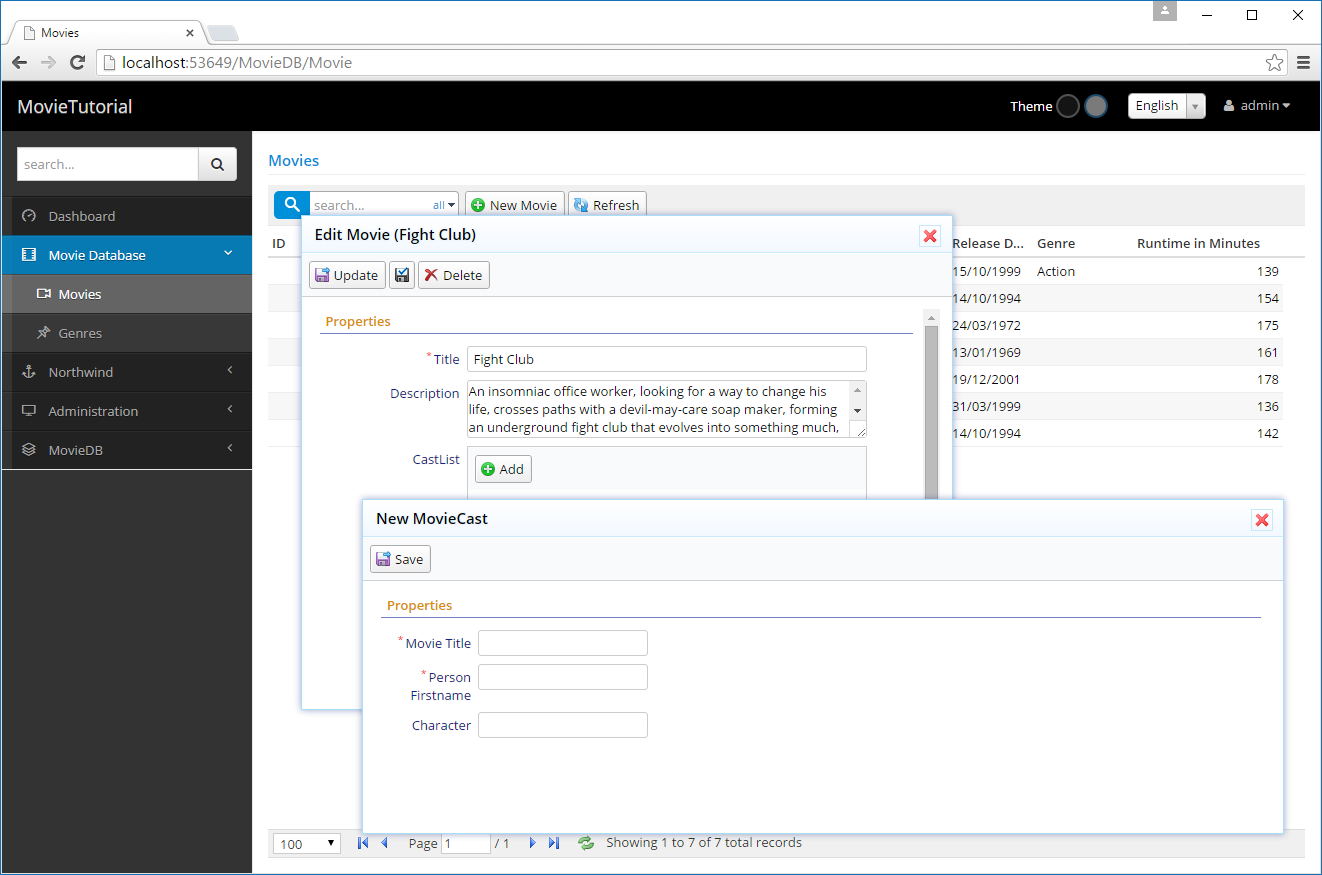
This dialog needs some CSS formatting. Movie title and person name fields accepts integer inputs ( as they are actually MovieId and PersonId fields).
Editing MovieCastForm.cs
We have FormKey("MovieDB.MovieCast") on top of our MovieCastEditDialog, so it uses MovieCastForm, which is also shared by MovieCastDialog.
It is possible to have multiple forms for one entity in Serenity. If i wanted to save MovieCastForm for MovieCastDialog, i would define a new form like MovieCastEditForm, but as i am going to eventually delete MovieCastDialog and MovieCastGrid classes, i don't mind.
Open MovieCastForm.cs and modify it:
namespace MovieTutorial.MovieDB.Forms
{
using Serenity.ComponentModel;
using System;
[FormScript("MovieDB.MovieCast")]
[BasedOnRow(typeof(Entities.MovieCastRow))]
public class MovieCastForm
{
[LookupEditor(typeof(Entities.PersonRow))]
public Int32 PersonId { get; set; }
public String Character { get; set; }
}
}
I have removed MovieId as this form is gonna be used in MovieDialog, so MovieCast entities will have the MovieId of the movie currently being edited in the MovieDialog automatically. Opening Lord of the Rings movie and adding a cast entry for the Matrix would be non-sense.
I have set editor type for PersonId field to a lookup editor and as i have already added a LookupScript attribute to MovieCastRow, i can reuse that information for setting the lookup key.
We could have also written [LookupEditor("MovieDB.Person")]
Build solution, launch and now MovieCastEditDialog has a better editing experience. But still has a bad look and PersonId field has a title of Person Id (or Person Firstname with < 1.6.1), why?
While writing this, a new Serene version (1.6.0) is out. I'm now updating Serenity packages to keep your tutorial experience up to date!
Fixing the Look Of MovieCastEditDialog
Let's check site.less to understand why our MovieCastDialog is not styled.
.s-MovieCastDialog {
> .size { .widthAndMin(650px); }
.dialog-styles(@h: auto, @l: 150px, @e: 400px);
.s-PropertyGrid .categories { height: 260px; }
}
The CSS at the bottom of site.less is for the MovieCastDialog, not MovieCastEditDialog, because we defined this class ourselves, not with code generator.
We created a new dialog type, by copying MovieCastDialog and modifying it slightly, so now our new dialog has a CSS class of s-MovieCastEditDialog, but code generator only generated CSS rules for s-MovieCastDialog.
Serenity dialogs automatically assigns CSS classes to dialog elements, by prefixing type name with "s-". You can see this by inspecting the dialog in developer tools. MovieCastEditDialog has CSS classes of s-MovieCastEditDialog and s-MovieDB-MovieCastEditDialog, along with some like ui-dialog.
s-ModuleName-TypeName CSS class helps with individual styling when two modules has a type with the same name.
As we are not gonna actually use MovieCastDialog (we'll delete it), let's rename the one in site.less:
.s-MovieCastEditDialog {
> .size { .widthAndMin(550px); }
.dialog-styles(@h: auto, @l: 150px, @e: 300px);
.s-PropertyGrid .categories { height: 160px; }
}
Fixing the Dialog and PersonId Field Titles
Our dialog still has title MovieCast, we remember how to change it right?
Open MovieCastRow.cs and perform these modifications:
namespace MovieTutorial.MovieDB.Entities
{
//..
[ConnectionKey("Default"), DisplayName("Movie Casts"), InstanceName("Cast"),
TwoLevelCached]
//..
public sealed class MovieCastRow : Row, IIdRow, INameRow
{
/...
[DisplayName("Actor/Actress"), NotNull,
ForeignKey("[mov].Person", "PersonId"), LeftJoin("jPerson")]
public Int32? PersonId
{
get { return Fields.PersonId[this]; }
set { Fields.PersonId[this] = value; }
}
}
}
First, we changed DisplayName and InstanceName attributes to set dialog title. Also change PersonId field title to Actor/Actress. Now MovieCastEditDialog has a bit better look:
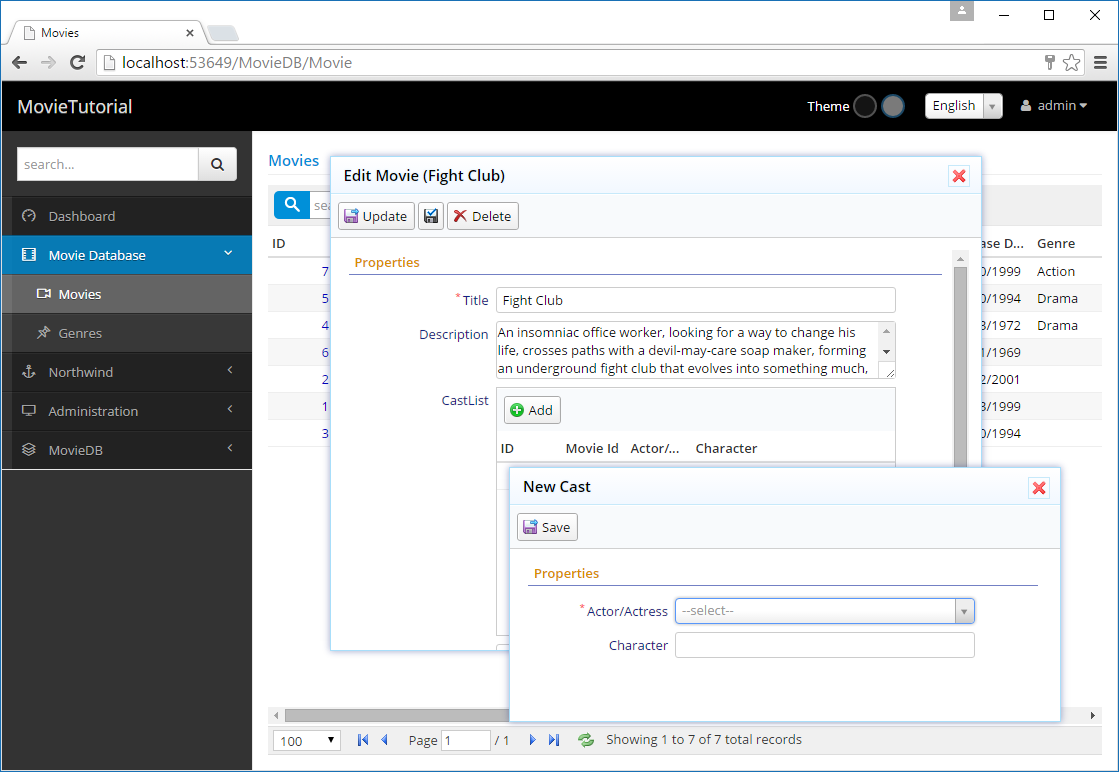
Fixing MovieCastEditor Columns
MovieCastEditor is currently using columns defined in MovieCastColumns.cs (because it has [ColumnsKey("MovieDB.MovieCast")] on class declaration).
We have MovieCastId, MovieId, PersonId (shown as Actor/Actress) and Character columns there. It is better to show only Actor/Actress and Character columns.
But we don't want to show PersonId (integer value), but instead their full name, so we'll declare this field in MovieCastRow.cs first:
namespace MovieTutorial.MovieDB.Entities
{
//...
public sealed class MovieCastRow : Row, IIdRow, INameRow
{
// ...
[DisplayName("Person Firstname"), Expression("jPerson.Firstname")]
public String PersonFirstname
{
get { return Fields.PersonFirstname[this]; }
set { Fields.PersonFirstname[this] = value; }
}
[DisplayName("Person Lastname"), Expression("jPerson.Lastname")]
public String PersonLastname
{
get { return Fields.PersonLastname[this]; }
set { Fields.PersonLastname[this] = value; }
}
[DisplayName("Actor/Actress"),
Expression("(jPerson.Firstname + ' ' + jPerson.Lastname)")]
public String PersonFullname
{
get { return Fields.PersonFullname[this]; }
set { Fields.PersonFullname[this] = value; }
}
// ...
public class RowFields : RowFieldsBase
{
// ...
public readonly StringField PersonFirstname;
public readonly StringField PersonLastname;
public readonly StringField PersonFullname;
// ...
}
}
}
and modify MovieCastColumns.cs:
namespace MovieTutorial.MovieDB.Columns
{
using Serenity.ComponentModel;
using System;
[ColumnsScript("MovieDB.MovieCast")]
[BasedOnRow(typeof(Entities.MovieCastRow))]
public class MovieCastColumns
{
[EditLink, Width(220)]
public String PersonFullname { get; set; }
[EditLink, Width(150)]
public String Character { get; set; }
}
}
Rebuild and cast grid has better columns:
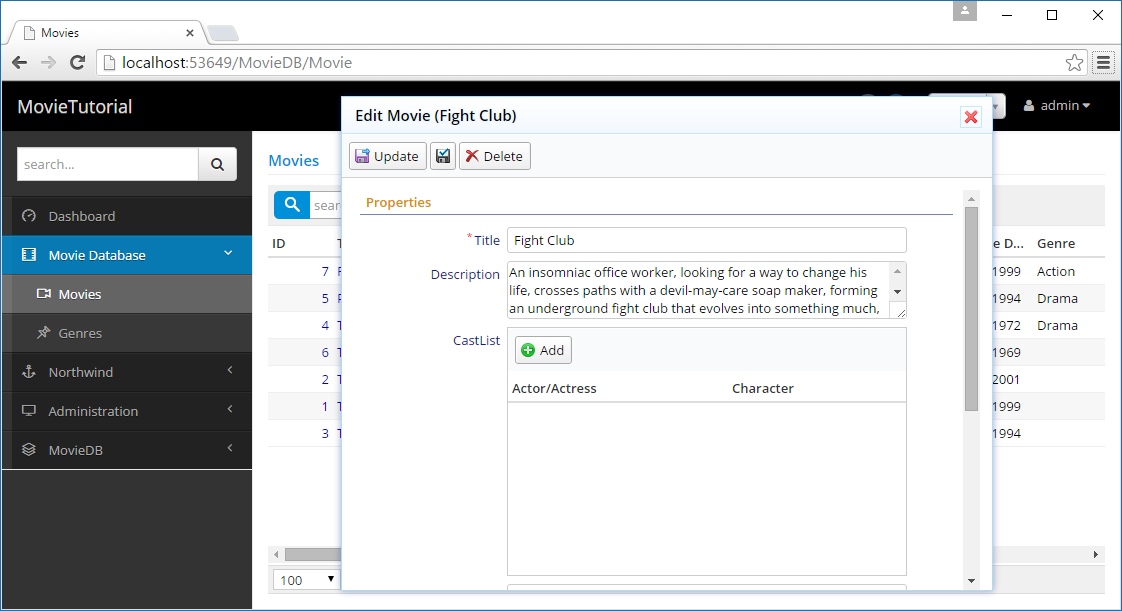
Now try adding an actor/actress, for example, Keanu Reeves / Neo:
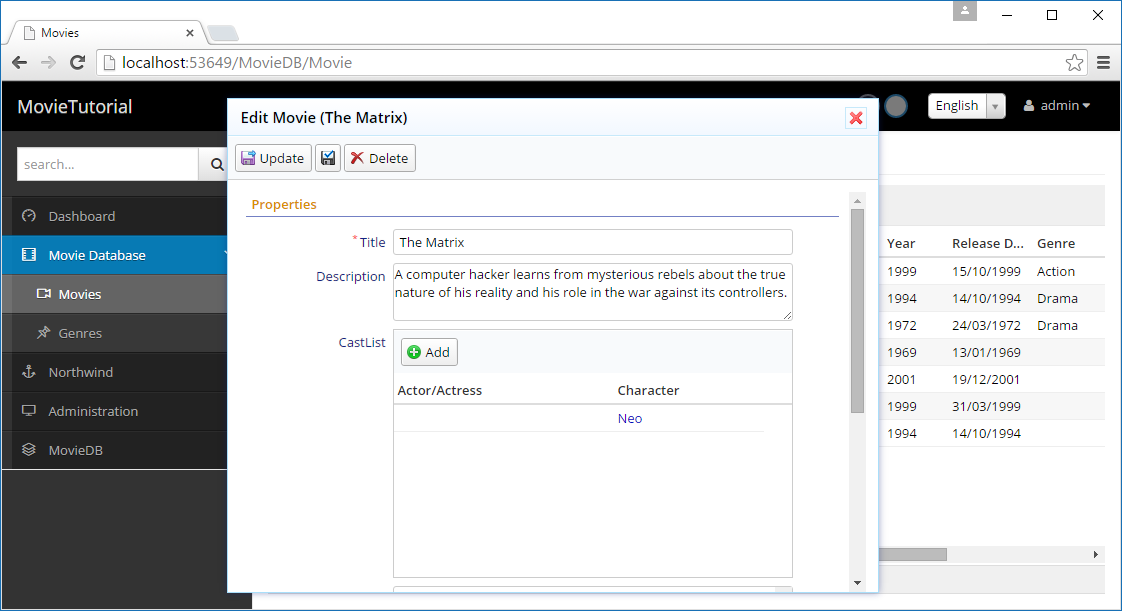
Why Actor/Actress column is empty??
Resolving Empty Actor/Actress Column Problem
Remember that we are editing in-memory. There is no service call involved here. So, grid is displaying whatever entity is sent back to it from the dialog.
When you click the save button, dialog builds an entity to save like this:
{
PersonId: 7,
Character: 'Neo'
}
These fields corresponds to the form fields you previously set in MovieCastForm.cs:
public class MovieCastForm
{
[LookupEditor(typeof(Entities.PersonRow))]
public Int32 PersonId { get; set; }
public String Character { get; set; }
}
There is no PersonFullname field in this entity, so grid can't display its value.
We need to set PersonFullname ourself. Let's first transform T4 templates to have access to PersonFullname field that we recently added, then edit MovieCastEditor.cs:
namespace MovieTutorial.MovieDB
{
// ...
public class MovieCastEditor : GridEditorBase<MovieCastRow>
{
// ...
protected override bool ValidateEntity(MovieCastRow row, int? id)
{
if (!base.ValidateEntity(row, id))
return false;
row.PersonFullname = PersonRow.Lookup
.ItemById[row.PersonId.Value].Fullname;
return true;
}
}
}
ValidateEntity is a method from our GridEditorBase class in Serene. This method is called when Save button is clicked to validate the entity, just before it is going to be added to the grid. But we are overriding it here for another purpose (to set PersonFullname field value) rather than validation.
As we saw before, our entity has PersonId and Character fields filled in. We can use the value of PersonId field to determine the person full name.
For this, we need a dictionary that maps PersonId to their Fullname values. Fortunately, person lookup has such a dictionary. We can access the lookup for PersonRow through its Lookup property.
Another way to access person lookup is by Q.GetLookup('MovieDB.Person'). The one in PersonRow is just a shortcut defined by T4 templates.
All lookups has a ItemById dictionary that allows you to access an entity of that type by its ID.
Lookups are a simple way to share server side data with client side. But they are only suitable for small sets of data.
If a table has hundreds of thousands of records, it wouldn't be reasonable to define a lookup for it. In that case, we would use a service request to query a record by its ID.
Defining CastList in MovieRow
While having a Movie dialog open, and at least one cast in CastList, click save button, and you'll get such an error:
Could not find field 'CastList' on row of type 'MovieRow'.
This error is raised from -> Row deserializer (JsonRowConverter for JSON.NET) at server side.
We defined CastList property in MovieForm, but have no corresponding field declaration in MovieRow. So deserializer can't find where to write CastList value that is received from client side.
If you open developer tools with F12, click Network tab, and watch AJAX request after clicking Save button, you'll see that it has such a request payload:
{
"Entity": {
"Title": "The Matrix",
"Description": "A computer hacker...",
"CastList": [
{
"PersonId":"1",
"Character":"Neo",
"PersonFullname":"Keanu Reeves"
}
],
"Storyline":"Thomas A. Anderson is a man living two lives...",
"Year":1999,
"ReleaseDate":"1999-03-31",
"Runtime":136,
"GenreId":"",
"Kind":"1",
"MovieId":1
}
}
Here, CastList property can't be deserialized at server side. So we need to declare it in MovieRow.cs:
namespace MovieTutorial.MovieDB.Entities
{
// ...
public sealed class MovieRow : Row, IIdRow, INameRow
{
[DisplayName("Cast List"), SetFieldFlags(FieldFlags.ClientSide)]
public List<MovieCastRow> CastList
{
get { return Fields.CastList[this]; }
set { Fields.CastList[this] = value; }
}
public class RowFields : RowFieldsBase
{
// ...
public readonly RowListField<MovieCastRow> CastList;
// ...
}
}
}
We defined a CastList property that will accept a List of MovieCastRow objects. The type of Field class that is used for such row list properties is RowListField
By adding [SetFieldFlags(FieldFlags.ClientSide)] attribute, we specified that this field is not available directly in database table, thus can't be selected through simple SQL queries. It is analogous to an unmapped field in other ORM systems.
Now, when you click the Save button, you will not get an error.
But reopen the Matrix entity you just saved. There is no cast entry there. What happened to Neo?
As this is an unmapped field, so movie Save service just ignored the CastList property.
Handling Save for CastList
Open MovieRepository.cs, find the empty MySaveHandler class, and modify it like below:
private class MySaveHandler : SaveRequestHandler<MyRow>
{
protected override void AfterSave()
{
base.AfterSave();
if (Row.CastList != null)
{
var mc = Entities.MovieCastRow.Fields;
var oldList = IsCreate ? null :
Connection.List<Entities.MovieCastRow>(
mc.MovieId == this.Row.MovieId.Value);
new Common.DetailListSaveHandler<Entities.MovieCastRow>(
oldList, Row.CastList,
x => x.MovieId = Row.MovieId.Value).Process(this.UnitOfWork);
}
}
}
MySaveHandler, processes both CREATE (insert), and UPDATE service requests for Movie rows. As most of its logic is handled by base SaveRequestHandler class, its class definition was empty before.
We should first wait for Movie entity to be inserted / updated successfully, before inserting / updating the cast list. Thus, we are including our customized code by overriding the base AfterSave method.
If this is CREATE (insert) operation, we need the MovieId field value to reuse in MovieCast records. As MovieId is an IDENTITY field, it is only available after inserting the movie record.
As we are editing cast list in memory (client-side), this will be a batch update.
We need to compare old list of the cast records for this movie to the new list of cast records, and INSERT/UPDATE/DELETE them.
Let's say we had cast records A, B, C, D in database for movie X.
User did some modifications in edit dialogs to cast list, and now we have A, B, D, E, F.
So we need to update A, B, D (in case character / actor changed), delete C, and insert new records E and F.
DetailListSaveHandler handles these comparisons and insert/update/delete operations automatically (by ID values).
To get a list of old records, we need to query database if this is an UPDATE movie operation. If this is a CREATE movie operation there shouldn't be any old cast record.
We are using Connection.List< Entities.MovieCastRow > extension method. Connection here is a property of SaveRequestHandler that returns the current connection used. List selects records that matches the specified criteria (mc.MovieId == this.Row.MovieId.Value).
this.Row refers to currently inserted / updated record (movie) with its new field values, so it contains the MovieId value (new or existing).
To update cast records, we are creating a DetailListHandler object, with old cast list, new cast list, and a delegate to set the MovieId field value in a cast record. This is to link new cast records with the current movie.
Then we call DetailListHandler.Process with current unit of work. UnitOfWork is a special object that wraps the current connection/transaction.
All Serenity CREATE/UPDATE/DELETE handlers works with implicit transactions (IUnitOfWork).
Handling Retrieve for CastList
We are not done yet. When a Movie entity is clicked in movie grid, movie dialog loads the movie record by calling the movie Retrieve service. As CastList is an unmapped field, even if we saved them properly, they won't be loaded into the dialog.
We need to also edit MyRetrieveHandler class in MovieRepository.cs:
private class MyRetrieveHandler : RetrieveRequestHandler<MyRow>
{
protected override void OnReturn()
{
base.OnReturn();
var mc = Entities.MovieCastRow.Fields;
Row.CastList = Connection.List<Entities.MovieCastRow>(q => q
.SelectTableFields()
.Select(mc.PersonFullname));
}
}
Here, we are overriding OnReturn method, to inject CastList into movie row just before returning the it from retrieve service.
I used a different overload of Connection.List extension, which allows me to modify the select query.
By default, List selects all table fields (not foreign fields coming from other tables), but to show actor name, i needed to also select PersonFullName field.
Now build the solution, and we can finally list / edit the cast.
Handling Delete for CastList
When you try to delete a Movie entity, you'll get foreign key errors. You could use a "CASCADE DELETE" foreign key while creating MovieCast table. But we'll handle this at repository level again:
private class MyDeleteHandler : DeleteRequestHandler<MyRow>
{
protected override void OnBeforeDelete()
{
base.OnBeforeDelete();
var mc = Entities.MovieCastRow.Fields;
foreach (var detailID in Connection.Query<Int32>(
new SqlQuery()
.From(mc)
.Select(mc.MovieCastId)
.Where(mc.MovieId == Row.MovieId.Value)))
{
new DeleteRequestHandler<Entities.MovieCastRow>().Process(this.UnitOfWork,
new DeleteRequest
{
EntityId = detailID
});
}
}
}
The way we implemented this master/detail handling is not very intuitive and included several manual steps at repository layer. Keep on reading to see how easily it could be done by using an integrated feature (MasterDetailRelationAttribute).
Handling Save / Retrieve / Delete (Serenity 1.6.3+)
Master/detail relations are an integrated feature (at least on server side) with Serenity 1.6.3+, so instead of manually overriding Save / Retrieve and Delete handlers, i'll use a new attribute, MasterDetailRelation (but of course i'll have to upgrade to 1.6.3).
Open MovieRow.cs and modify CastList property:
[DisplayName("Cast List"), MasterDetailRelation(foreignKey: "MovieId"), ClientSide]
public List<MovieCastRow> CastList
{
get { return Fields.CastList[this]; }
set { Fields.CastList[this] = value; }
}
We specified that this field is a detail list of a master/detail relation and master ID field (foreignKey) of the detail table is MovieId.
Now undo all changes we made in MovieRepository.cs:
private class MySaveHandler : SaveRequestHandler<MyRow> { }
private class MyDeleteHandler : DeleteRequestHandler<MyRow> { }
private class MyRetrieveHandler : RetrieveRequestHandler<MyRow> { }
We'll just have to make a little change in MovieCastRow.cs to select PersonFullname on retrieve (just like we did manually in MyRetrieveHandler):
[DisplayName("Actor/Actress"),
Expression("(jPerson.Firstname + ' ' + jPerson.Lastname)")]
[MinSelectLevel(SelectLevel.List)]
public String PersonFullname
{
get { return Fields.PersonFullname[this]; }
set { Fields.PersonFullname[this] = value; }
}
This ensures that PersonFullname field is selected on retrieve. Otherwise, it wouldn't be loaded as only table fields are selected by default.
Now build your project and you'll see same functionality works with much less code.
MasterDetailRelationAttribute triggers an instrinsic (automatic) behavior, MasterDetailRelationBehavior which intercepts Retrieve/Save/Delete handlers and methods we had overriden before and performs similar operations.
So we did the same thing, but this time declaratively, not imperatively (what should be done, instead of how to do it)
https://en.wikipedia.org/wiki/Declarative_programming
We'll see how to write your own request handler behaviors in following chapters.